|
|
 |
|
Calanoida ( Order ) |
|
|
|
Metridinidae ( Family ) |
|
|
|
Pleuromamma ( Genus ) |
|
|
| |
Pleuromamma johnsoni Ferrari & Saltzman, 1998 (F,M) | |
| | | | | | | Ref.: | | | Ferrari & Saltzman, 1998 (p.206, figs.F,M, Rem.: asymmetric morphs) |  issued from : F.D. Ferrari & J. Saltzman in Plankton Biol. Ecol., 1998, 45 (2). [p.208, Fig.1]. Female (from eastern tropical Pacific): A, habitus (lateral right side); B, urosome (dorsal); C, genital complex (ventral) (arrow to copulatory pore); D, genital complex (lateral right side) ( arrow to copulary pore); E, rostral area (lateral) (arrow to dorsal knob); F, idem (frontal view) ( arrow to dorsal knob); G, labrum with paragnaths (cuticular ridge between circles); H, P5; I, caudal ramus. Nota: Dark organ on right or left side, anteriorly and posteriorly pointed, ventrally and dorsally rounded.
|
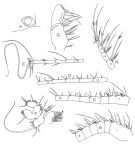 issued from : F.D. Ferrari & J. Saltzman in Plankton Biol. Ecol., 1998, 45 (2). [p.209, Fig.2]. Female (from eastern tropical Pacific): A, dark organ on lateral right side of cephalothorax; B, A1 segments 1-6 ( arrows to location of extra setae on male left A1); C, A1 segments 7-12 ( arrows to location of extra setae on male left A1); D, A1 segments 13-17; E, A1 segments 18-23; F, Mx1 (posterior) (setules not drawn; arrow to anterior seta); G, Mxp (syncoxa and basis); H, Mxp (ramal segments). Nota: Thoracic, abdominal somites and ramal segmets are numbered according to their appearance during development as interpreted from data of Hulsemann (1991).
|
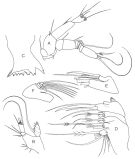 issued from : F.D. Ferrari & J. Saltzman in Plankton Biol. Ecol., 1998, 45 (2). [p.210, Fig.3]. Female (from eastern tropical Pacific): A, A2; B, Mxp (palp); C, Md (bitting edge); D, Mx2 (first five endites posterior, including proximal basal endite); E, Mx2 (2 basal endites posterior); F, Mx2 (2 distalbasal endite + outer ramus anterior).
|
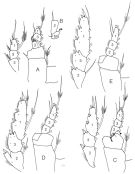 issued from : F.D. Ferrari & J. Saltzman in Plankton Biol. Ecol., 1998, 45 (2). [p.211, Fig.4]. Female (from eastern tropical Pacific): A, P1 (anterior), exopod detached to left; B, P1 (basis (basis and exopod 2 (lateral) (arrow to posterior attenuation of basis); C, P2 (anterior), exopod detached to left (curved arrow to proximal paired small attenuations; long arrow to proximal large attenuation; arrowhead to medial attenuation bearing setae at C2); D, P3 (posterior), exopod detached to left; E, P4 (posterior), exopod detached to left. Nota: Thoracic and abdominal somites are numbered according to their appearance during development as interpreted from data of Hulsemann (1991).
|
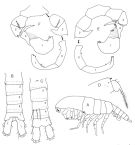 issued from : F.D. Ferrari & J. Saltzman in Plankton Biol. Ecol., 1998, 45 (2). [p.212, Fig.5]. Male (from eastern tropical Pacific): A, habitus (lateral left side); B, urosome (dorsal); C, urosome (ventral); D, rostral area (lateral) ( arrow to dorsal knob); E, P5 (anterior) (arrow connects right coxa to basis and exopod2 to 3; F, P5 (posterior) ( arrows connect right exopod 2 to exopod 3). Nota: Dark organ on left side only. Nota: Thoracic, abdominal somites and ramal segmets are numbered according to their appearance during development as interpreted from data of Hulsemann (1991).
|
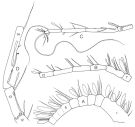 issued from : F.D. Ferrari & J. Saltzman in Plankton Biol. Ecol., 1998, 45 (2). [p.213, Fig.6]. Male (from eastern tropical Pacific): A-D, right A1 (segments 1-6, 7-12, 13-17, 13-14, respectively) (arrowhead to tip of distal rigid seta).
| | | | | Compl. Ref.: | | | Williams R., 2013 (p.71, figs., Table 3.2, 3.4, 3.6, 3.7, Appendix A, C; C & N composition, trophic level) | | | | NZ: | 1 | | |
|
Distribution map of Pleuromamma johnsoni by geographical zones
|
| | | | Loc: | | | E tropical Pacif. (Tehantepec Bowl - Costa Rica Dome) | | | | N: | 2 | | | | Lg.: | | | (772) F: 3,9-3,3; M: 3,5-2,6; {F: 3,3-3,9; M: 2,6-3,5} | | | | Rem.: | For Ferrari & Saltzman (p.214), In both sexes there is an asymmetrical knob dorsal to rostral area (absent in P. robusta, P. antarctica and P. scutullata), the dark organ is pointed anteriorly and posteriorly (these edges are rounded in the other three species), the ratio of prosome to urosome is slightly greater than the other species (females: 2.3-2.4 vs 1.8-2.0 for the three other species; males: 2.4-2.9 vs 2.0-2.3 for P. robusta and 1.6-2.2 for P. antarctica and P. scutellata. Females differ from P. robusta and P. antarctica in the position of the copulary pore which is located about half the distance between anterior and posterior edge of genital segment; the presence of medial and lateral denticles in the distal sefgment of P5; the absence of asymmetrical spinules on urosomal segment 1; symmetrical denticulations on caudal rami.
males lack a distal attenuation on the 14th segment of the geniculate A1; lack an indentation on the medial attenuation of the middle exopodal segment of left P5; unique pattern of spinulation restricted to the ventral face of urosomal segment 3.
Males and females from the Volcano 7 area have poorly developed musculature when compared to specimens from other localities. | | | Last update : 28/01/2015 | |
|
|
 Any use of this site for a publication will be mentioned with the following reference : Any use of this site for a publication will be mentioned with the following reference :
Razouls C., Desreumaux N., Kouwenberg J. and de Bovée F., 2005-2025. - Biodiversity of Marine Planktonic Copepods (morphology, geographical distribution and biological data). Sorbonne University, CNRS. Available at http://copepodes.obs-banyuls.fr/en [Accessed October 21, 2025] © copyright 2005-2025 Sorbonne University, CNRS
|
|
 |
 |









